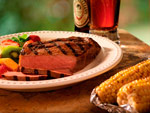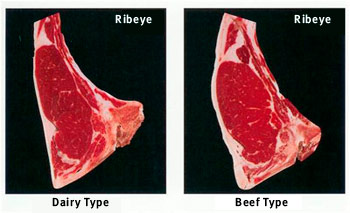CAB Mythbusters
What they thought they knew that just ain't true.
 When I was hired by Certified Angus Beef LLC (CAB) in 2006, I was stoked. I was finishing my senior year of college and, like the typical fresh-faced grad, I knew it all. I knew I was joining an enthusiastic team that promoted the world's largest brand of beef. I knew they were going to pay me to do what I loved: writing about and for the livestock industry. I knew CAB was a quality product. (They fed me well during my training!)
When I was hired by Certified Angus Beef LLC (CAB) in 2006, I was stoked. I was finishing my senior year of college and, like the typical fresh-faced grad, I knew it all. I knew I was joining an enthusiastic team that promoted the world's largest brand of beef. I knew they were going to pay me to do what I loved: writing about and for the livestock industry. I knew CAB was a quality product. (They fed me well during my training!)
But, I didn't know how much I didn't know.
I soon began to hear rumblings from classmates, neighbors back home and even my own family, such as, "Isn't that just a black-hided program?" or "Don't a lot of dairy cows qualify?" Well, the quick answers are "no" and "no." But one more thing I knew: Those two-letter answers never satisfy those who truly want to understand.
So I set out to learn and then share. After four years on the job, I guess I'm finally ready to give myself the title "Mythbuster Miranda." Each week on our blog, I address the misleading comments we hear in coffee shops, convention center hallways and even (gasp) in formal presentations to cattlemen. Here, we'll unveil a new myth each month and the tried and true research that blows the top off some long-held industry urban (or shall I say rural?) legends about high-quality beef production.
I'll start with one of the first I mentioned:
Myth: Certified Angus Beef® (CAB®) takes in a bunch of dairy cows.
Fact: Cows, dairy or otherwise, don't make it into the brand because we require "A" maturity, which means the cattle are 9 to 30 months of age at harvest. We do this because tenderness decreases with age.
Specific to dairy type in general, there is the superior muscling specification that effectively limits dairy influence. That's especially important when it comes to plate presentation. Everybody knows what a good ribeye looks like. (See the photo at the top of this page.)
 Finished beef animals tend to have fuller, more rounded muscling that results in the appearance consumers and chefs consider more desirable when cut into steaks. The lighter muscling common to dairy cattle often leads to thinner wholesale cuts that produce long, rectangular shapes when fabricated into retail items.
Finished beef animals tend to have fuller, more rounded muscling that results in the appearance consumers and chefs consider more desirable when cut into steaks. The lighter muscling common to dairy cattle often leads to thinner wholesale cuts that produce long, rectangular shapes when fabricated into retail items.
That's just one of 10 carcass specifications the brand has, but you'll just have to check back next month to learn more.
To get a weekly dose of this feature, visit the "Black Ink Blog" at www.blackinkwithcab.com.









